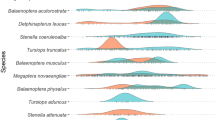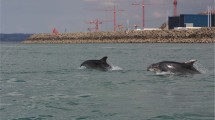Abstract
Bottlenose dolphins (Tursiops truncatus) face a variety of threats, including risk of exposure to brevetoxins produced by blooms of the harmful alga Karenia brevis. This study investigated brevetoxin exposure in a population of dolphins inhabiting Sarasota Bay, Florida, USA (27°N, 82°W), utilizing tissues from dolphins recovered between 1994 and 2003. Brevetoxin levels detected by ELISA in tissues, gastric samples and excreta from dolphin carcasses (n = 19) associated with K. brevis blooms were compared with with levels in carcasses (n = 16) associated with background K. brevis conditions. In the K. brevis-exposed set, 84% of dolphin carcasses recovered during K. brevis blooms had detectable brevetoxin levels, with values ranging between 7 and 2,896 ng PbTx-3 eq g−1. Over 50% of dolphin carcasses recovered during non-bloom conditions also tested positive by ELISA for brevetoxins, with concentrations ranging from 6 to 44 ng PbTx-3 eq g−1. Control samples from the east coast of Florida were negative by the ELISA. Results from this study establish baseline brevetoxin body burdens in a dolphin population frequently exposed to K. brevis blooms, and data indicate that dolphin carcasses not associated with large-scale mortality events can contain levels of brevetoxins comparable to carcasses stranding during such events.


Similar content being viewed by others
References
Barros NB, Wells RS (1998) Prey and feeding patterns of resident bottlenose dolphins (Tursiops truncatus) in Sarasota Bay, Florida. J Mammal 79:1045–1059
Benson JM, Tischler DL, Baden DG (1999) Uptake, tissue distribution, and excretion of brevetoxin 3 administered to rats by intratracheal instillation. J Toxicol Environ Health 57:345–355
Bossart GD, Baden DG, Ewing RY, Roberts B, Wright SD (1998) Brevetoxicosis in manatees (Trichechus manatus latirostris) from the 1996 epizootic: gross, histologic, and immunohistochemical features. Toxicol Pathol 26:276–282
Cattet M, Geraci JR (1993) Distribution and elimination of ingested brevetoxin (PbTx-3) in rats. Toxicon 31:1483–1486
Daugbjerg N, Hansen G, Larsen J, Moestrup O (2000) Phylogeny of some of the major genera of dinoflagellates based on ultrastructure and partial LSU rDNA sequence data, including the erection of three new genera of unarmoured dinoflagellates. Phycologia 39:302–317
Dickey RW, Plakas SM, Jester ELE, El Said KR, Johannessen JN, Flewelling LJ, Scott P, Hammond DG, Van Dolah FM, Leighfield TA, Bottein Dachraoui M-Y, Ramsdell JS, Pierce RH, Henry MS, Poli MA, Walker C, Kurtz J, Naar J, Baden DG, Musser SM, White KD, Truman P, Miller A, Hawryluk TP, Wekell MM, Stirling D, Quilliam MA, Lee JK (2004) Multi-laboratory study of five methods for the determination of brevetoxins in shellfish tissue extracts. In: Steidinger KA, Landsberg JH, Tomas CR, Vargo GA (eds) Harmful Algae 2002. Florida Fish and Wildlife Conservation Commission, Florida Institute of Oceanography, and Intergovernmental Oceanographic Commission of UNESCO, pp 300–302
Fauquier D, Flewelling L, Manire C, Ramsdell J, Gannon J, Kinsel M, Stacy B, Rotstein D, Barros N, Foley A, Landsberg J (2006) Brevetoxin-induced morbidity and mortality in stranded bottlenose dolphins and sea turtles from central west Florida in 2005. NOAA State of the Research on Red Tide in the Gulf of Mexico Forum, 17–20 July 2005, Sarasota
Flewelling LJ, Naar JP, Abbott JP, Baden DG, Barros NB, Bossart GD, Bottein MYD, Hammond DG, Haubold EM, Heil CA, Henry MS, Jacocks HM, Leighfield TA, Pierce RH, Pitchford TD, Rommel SA, Scott PS, Steidinger KA, Truby EW, Van Dolah FM, Landsberg JH (2005) Red tides and marine mammal mortalities. Nature 435:755–756
Forrester DJ, Gaskin JM, White FH, Thompson NP, Quick Jr JA, Henderson GE, Woodard JC, Robertson WD (1977) An epizootic of waterfowl associated with a red tide episode in Florida. J Wildl Dis 13:160–167
Geraci JR (1989) Clinical investigation of the 1987–88 mass mortality of bottlenose dolphins along the US central and south Atlantic coast. PP 1–63 in Final report to the National Marine Fisheries Service, US Navy Office of Naval Research, and Marine Mammal Commission Guelph, Ontario: Ontario Veterinary College, University of Guelph
Gunter G, Williams RH, Davis CC, Smith FGW (1948) Catastrophic mass mortality of marine animals and coincident phytoplankton bloom on the west coast of Florida, November 1946 to August 1947. Ecol Monogr 18:309–324
Kennedy CJ, Schulman LS, Baden DG, Walsh PJ (1992) Toxicokinetics of brevetoxin PbTx-3 in the gulf toadfish, Opsanus beta, following intravenous administration. Aquat Toxicol 22:3–13
Landsberg JH, Steidinger KA (1998) A historical review of Gymnodinium breve red tides implicated in mass mortalities of the manatee (Trichechus manatus latirostris) in Florida, USA. In: Reguera B, Blanco J, Fernandez ML, Wyatt T (eds) Harmful Algae. Xunta de Galicia and Intergovernmental Oceanographic Commission, UNESCO, pp 97–100
Mase B, Jones W, Ewing R, Bossart G, Van Dolah F, Leighfield T, Busman M, Litz J, Roberts B, Rowles T (2000) Epizootic in bottlenose dolphins in the Florida panhandle: 1999–2000. In: Baer CK (eds) Proceedings of the American Association of Zoo Veterans and International Association for Aquatic Animal Medicine, pp 522–525
Naar J, Bourdelais A, Tomas C, Kubanek J, Whitney PL, Flewelling L, Steidinger K, Lancaster J, Baden DG (2002) A competitive ELISA to detect brevetoxins from Karenia brevis (formerly Gymnodinium breve) in seawater, shellfish, and mammalian body fluid. Environ Health Perspect 110:179–185
O’Shea TJ, Rathbun GB, Bonde RK, Buergelt CD, Odell DK (1991) An epizootic of Florida manatees associated with a dinoflagellate bloom. Mar Mamm Sci 7:165–179
Pierce RH (1986) Red tide (Ptychodiscus brevis) toxin aerosols: A review. Toxicon, vol24, pp 955–965
Plakas SM, Wang Z, El Said KR, Jester ELE, Granade HR, Flewelling L, Scott P, Dickey RW (2004) Brevetoxin metabolism and elimination in the Eastern oyster (Crassostrea virginica) after controlled exposures to Karenia brevis. Toxicon 44:677–685
Poli MA, Templeton CB, Thompson WL, Hewetson JF (1990) Distribution and elimination of brevetoxin PbTx-3 in rats. Toxicon 28:903–910
Scott GP, Burn DM, Hansen LJ (1988) The dolphin dieoff: long-term effects and recovery of the population. In: Proceedings of the Oceans ‘88 Conference, pp 819–823
Steidinger KA, Carlson P, Baden D, Rodriguez C, Seagle J (1998) Neurotoxic shellfish poisoning due to toxin retention in the clam Chione cancellata. In: Reguera B, Blanco J, Fernandez ML, Wyatt T (eds) Harmful Algae. Xunta de Galicia and Intergovernmental Oceanographic Commission of UNESCO, pp 457–458
Van Dolah FM, Doucette GJ, Gulland FMD, Rowles T, Bossart GD (2003) Impacts of algal toxins on marine mammals. In: Vos JG, Bossart GD, Fournier M, O’Shea TJ (eds) Toxicology of marine mammals. Taylor and Francis, New York, pp 247–269
Walker ST (1884) Fish mortality in the Gulf of Mexico. Proc US Natl Mus 6:105–109
Wells RS (2003) Dolphin social complexity: Lessons from long-term study and life history. In: de Waal FBM, Tyack PL (eds) Animal social complexity: intelligence, culture, and individualized societies. Harvard University Press, Cambridge, pp 32–56
Wells RS, Irvine AB, Scott MD (1980) The social ecology of inshore odontocetes. In: Herman LM (eds) Cetacean behavior: mechanisms and functions. Wiley, New York, pp. 263–317
Woofter RT, Brendtro K, Ramsdell JS (2005) Uptake and elimination of brevetoxin in blood of striped mullet (Mugil cephalus) after aqueous exposure to Karenia brevis. Environ Health Perspect 113:11–16
Acknowledgments
The authors would like to thank Gary Kirkpatrick, Val Palubok, Trish Blum, Nelio Barros, Shana Hamel, Dana Wetzel, Phil Mercurio, Carl Luer and Cathy Walsh of Mote Marine Laboratory, and Mary Silver and Dan Costa of the University of California at Santa Cruz, for helpful discussions, sample collection, logistical support, and/or laboratory assistance. This project was supported by the Disney Wildlife Conservation Fund, Long Marine Laboratory, National Marine Fisheries Service, Harbor Branch Oceanographic Institution Protect Wild Dolphins Program, Florida Fish and Wildlife Conservation Commission and the Chicago Zoological Society. This research was authorized by National Marine Fisheries Service under permit No. 522-1785. All work performed in this study complied with current laws of the USA.
Author information
Authors and Affiliations
Corresponding author
Additional information
Communicated by J.P. Grassle.
Rights and permissions
About this article
Cite this article
Fire, S.E., Fauquier, D., Flewelling, L.J. et al. Brevetoxin exposure in bottlenose dolphins (Tursiops truncatus) associated with Karenia brevis blooms in Sarasota Bay, Florida. Mar Biol 152, 827–834 (2007). https://doi.org/10.1007/s00227-007-0733-x
Received:
Accepted:
Published:
Issue Date:
DOI: https://doi.org/10.1007/s00227-007-0733-x




